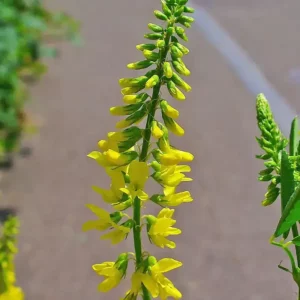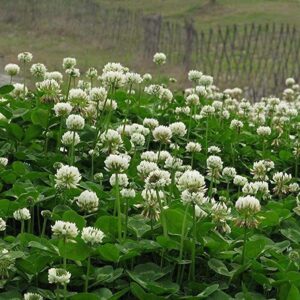+447709283333 | info@damavandpro.com

How to Grow Clover
Whether you’re a novice gardener planting clover seed for the first time or a seasoned green thumb looking for tips about introducing clover into your existing lawn, we’re here to provide some valuable insights for ensuring your clover lawn thrives.
Differing from ordinary clovers that are prone to struggle in periods of dry or cold weather, our specialized clover lawn seed boasts a deep root system that allows it to flourish in the UK and EU climates throughout the year! Consequently, using our exclusive clover lawn seed blend guarantees a robust, emerald green clover lawn that remains vibrant even when water supply is sparse.
Is planting a clover lawn different from sowing grass seed?
Planting a clover lawn is a straightforward task, bearing a striking resemblance to the process of sowing grass seed. This can be accomplished by simply dispersing the seeds across your lawn.
Why is clover beneficial for your lawn?
The specific variety of micro-clover included in our lawn seed blend is highly resistant to drought and easily adapts to a wide range of soil conditions prevalent in the UK and EU.

The seeds of this clover variety germinate and develop a robust taproot system that penetrates deep into the soil. As it decomposes, it generates new stems that traverse through the soil, branching out and sprouting new plants in their path!
When is the best time to plant a clover lawn?
- Our clover lawn seed is best sown during the spring or autumn seasons.
- For clover lawn seed to germinate, it requires a soil temperature above 8 degrees Celsius.
- Typically, this temperature is achieved around mid-March in the UK and EU.
- Clover lawn seed that is sown in the spring usually establishes well and experiences rapid growth.
-


Crimson Red Clover Seeds
£7.00 – £29.00Buy Now This product has multiple variants. The options may be chosen on the product page -


Mix White and Red Clover Seeds
£2.99 – £290.00Buy Now This product has multiple variants. The options may be chosen on the product page -

Sweet Clover Seed (Melilotus officinalis) 1kg Yellow Blossom
£20.00 -

White Clover Seeds: 1kg Grass Clover Oxalis
£25.00
Give your lawn a green boost with a beautiful clover patch!
Thinking of ditching the high-maintenance grass lawn? Consider a lush clover lawn instead! Here’s a simple guide to sowing your own:
Seeding Savvy:
- Seed Depth: Aim for 5-10mm deep, about the thickness of three stacked coins.
- Seeding Rate: Spread 50g of seeds per square meter for good coverage.
- Temperature Talk: Clover seeds germinate best in warm weather, ideally above 8°C. If you’re mixing clover with grass seed, aim for consistent day and night temperatures between 8-10°C for two weeks to ensure proper grass seed germination.
Prep Work:
- Clear the Ground: Remove weeds by hand or use a weed killer (if necessary) to create a clean planting area.
- Enrich the Soil: If your soil feels poor, add some topsoil to give your clover a healthy start.
- Level Up: Rake the area to create a smooth and even seedbed.
- Cultivate for Success: Leave the prepped area for 10-14 days. This allows any hidden weed seeds to sprout, making them easier to remove by hand.
-

1kg Red Clover Seed Organic Trifolium
£25.00 -


Clovers Seeds Flower Mix: The Gift That Keeps on Giving (Pollinators Love It!)
£7.99 – £289.99Buy Now This product has multiple variants. The options may be chosen on the product page -


Plant Growing Kit for Kids: Clover, Sunflower, Calendula – Fun Gift!
£12.00 -


White Wildflower Seeds – White Clover Seeds (Trifolium Repens)
£2.99
Seeding Time:

- Spread the Seeds: Use the recommended rate of 50g per square meter to ensure even growth.
- Rake it In: Gently rake the seeds into the topsoil to create good seed-to-soil contact.
- Firm Up: Finally, gently tamp down the seeded area with your foot or a roller to further improve seed contact with the soil.
Clover Tip: Unlike traditional grass, clover doesn’t require fertilizer! It actually helps fix nitrogen in the soil, benefiting nearby plants.
With a little care and these simple steps, you’ll be enjoying a beautiful and low-maintenance clover lawn in no time!
How to Spread Clover Seed by Hand
Hand spreading is needed for tiny clover seeds. Mix them with sand for better coverage. Water the seeds until the clover grows.
Growing Clover in Pots
With good light, clover grows easily indoors. Use well-draining soil and water frequently to keep it moist. A pot with a drainage hole and a saucer is ideal.
Clover Germination Temperature
Clover seeds germinate when soil is above 6°C, typically by mid-March. Spring planting works well, and clover can be sown with cereals.
Clover Lawn Aftercare: Keep Your Green Patch Thriving!

So you’ve sown your clover lawn – congrats! Now comes the fun part: watching those tiny sprouts transform into a lush green carpet. Here’s how to nurture your new clover babies:
Watering:
- Newborn Needs: For the first four weeks, water your clover lawn daily to keep the seeds nice and moist. This helps them germinate quickly and establish strong roots.
- Grown-Up Guzzler: Once established, clover surprises you with its water-sipping skills! Thanks to its clever roots, it needs less watering than a regular lawn. Plus, it doesn’t tolerate soggy soil, so less is definitely more in this case.
-


1kg White Clover Grass Lawn Seed: Low Maintenance, Natural Lawns
£29.99 -


Mix White & Red Clover Seeds: Gorgeous, Useful, Low-Maintenance Ground Cover for 200 Square Meter Landscape
£35.00 -


Persian Clover Seed (Trifolium resupinatum) 1kg
£20.00 -

Sainfoin Seeds – Premium Quality Onobrychis Vicifolia Seeds for High-Yielding Forage
£20.00
Mowing (Optional):

Clover’s a low-key kind of lawn. Unlike its high-maintenance grass cousins, it doesn’t require constant mowing. But if you prefer a tidy look, you can trim it occasionally.
- Mower Magic: Set your mower to the height you’d use for regular grass. This will trim any grass blades without harming the clover itself.
- Clover Clemency: The good news is, you can mow less often! Since clover grows slowly, you won’t need to whip out the mower as frequently.
Bonus Tip: Clover is a nitrogen-fixing champ! This means it helps improve the soil around it, making it a great addition to your garden.
By following these simple steps, you’ll be well on your way to a thriving clover lawn that requires minimal effort but delivers big on beauty and eco-friendliness. Now go forth and enjoy your low-maintenance green haven!
Skip the Fertilizer with a Clover Lawn!

Clover is a tough little plant! It can outcompete most common UK and EU garden weeds, meaning it takes care of itself for the most part. For those stubborn weeds that do pop up, simply pull them out by hand. Avoid weed killers, as they’ll harm your precious clover.
Here’s the best part: clover is a natural nitrogen-fixer! This means it enriches the soil around it, keeping your garden healthy and green without needing extra fertilizer. So ditch the fertilizer and embrace the low-maintenance beauty of a clover lawn!
What is the difference between Grass and Clover?
Crave a green lawn year-round? Skip the grass! Clover stays green from spring until the first frost, unlike grass which fades in summer. Enjoy a beautiful lawn with less winter prep!
How long does Clover take to Grow from Seed?
Plant your clover lawn in warm weather (spring or summer). Simply rake the soil, scatter the seeds, and give them a good drink. Warm temperatures mean clover sprouts in as little as 2 days, though it can take up to 10!
How do you Plant Clover?
Don’t bury your clover seeds deep! They’re much smaller than grass seeds. Aim for a shallow planting depth of 1/2 cm to 1 cm. After seeding, a roller can help gently firm the soil for better germination.
Does Clover go to Seed?
Insect pollination mainly occurs in the flowers. Seeds are viable after 12 days and fully ripen in a month, with 3-6 seeds per pod. Clover seed yield ranges from 13 to 151 kg per hectare, depending on the cultivar and conditions.
Does Clover get rid of Grass?
Clover is controversial. To keep a uniform lawn, remove it since it competes with grass for resources and attracts pests.
- What is a clover lawn?
- How to grow a clover lawn?
- Maintaining a clover lawn
